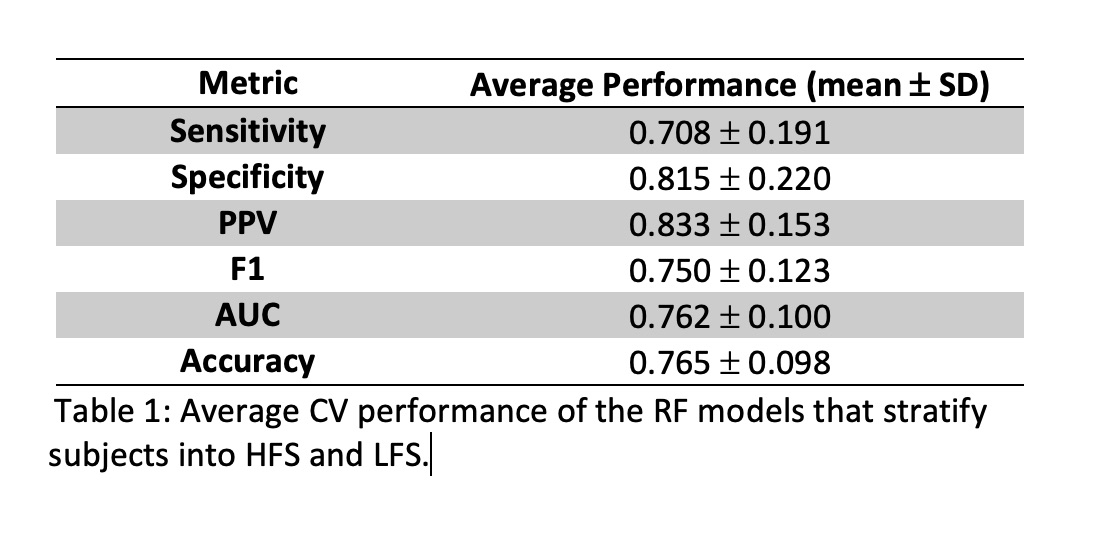Objective: To conduct a proof-of-concept study to demonstrate that objectively measured gait kinematics can predict the choice of subthalamic nucleus deep brain stimulation (STN-DBS) frequency among Parkinson’s patients.
Background: Long-term outcomes reveal that the cardinal symptoms of Parkinson’s disease (PD) maintain robust responses to high frequency STN-DBS (HFS, 130-185 Hz), while axial and gait symptoms worsen [1]. In contrast, low frequency stimulation (LFS, 60 Hz) may reduce freezing episodes and improve gait in chronic DBS patients [2]. Additionally, computational models suggest that gait parameters can help identify which patients could benefit from HFS vs LFS [3].
Method: Three Parkinson’s subjects (mean age 61.3 years [57-67], mean disease duration 15 years [11-21]) with chronic STN DBS (mean stimulation duration 3 years [1-5]) had their gait kinematics analyzed by an instrumented Stand and Walk (SAW) test in the levodopa medicated state. The mean and standard deviation of gait parameters collected from wearable sensors for each patient were measured over 8 trials. Paired t-test was conducted to examine whether gait parameters were statistically different between HFS vs. LFS. Also, non-linear machine learning (ML) models, specifically, random forest (RF) [4], were used to analyze the measurements to determine if the gait parameters could stratify patients into HFS vs LFS groups. The models were objectively evaluated using leave-one-out cross-validation (CV) [5], in which RF models were trained on two patients and tested on the third left-out patient, to examine their generalizability. Parameter pruning was performed using Gini measure of node impurities [6] to only include the most important parameters and improve model performance. The average CV performance was calculated.
Results: On average paired t-test suggested 20% of measured parameters were significantly different for HFS vs LFS (p-value < 0.05). Eleven gait parameters were included in RF after parameter pruning. RF was able to accurately identify HFS vs LFS in 76.5 ± 9.8% of SAW trials (Table 1).
Conclusion: In this small cohort, significant gait kinematic differences exist between HFS and LFS STN-DBS. Robust ML models capable of predicting the best stimulation frequency based on these objective measurements in the medicated state show promise and will require a larger cohort to validate.
References: [1] Castrioto A, Lozano AM, Poon YY, Lang AE, Fallis M, Moro E. Ten-year outcome of subthalamic stimulation in Parkinson disease: a blinded evaluation. Arch Neurol 2011;68:1550-1556. [2] Moreau C, Defebvre L, Destee A, et al. STN-DBS frequency effects on freezing of gait in advanced Parkinson disease. Neurology 2008;71:80-84 [3] Khojandi A, Shylo O, Mannini L, Kopell BH, Ramdhani RA. Stratifying Parkinson’s Patients With STN-DBS Into High- Frequency or 60 Hz-Frequency Modulation Using a Computational Model. Neuromodulation : journal of the International Neuromodulation Society. 2017;20(5):450-5. Epub 2017/05/10. doi: 10.1111/ner.12607. PubMed PMID: 28480524. [4] L. Breiman. Random Forests. In: Machine learning. 2001; 45 (1), 5-32 [5] Pedregosa, F., Varoquaux, G., Gramfort, A., Michel, V., Thirion, B., Grisel, O., Blondel, M., Prettenhofer, P., Weiss, R., Dubourg, V., Vanderplas, J., Passos, A., Cournapeau, D., Brucher, M., Perrot, M. & Duchesnay, E. Scikit-learn: Machine Learning in Python. Journal of Machine Learning Research, 2011; 12: 2825-2830. [6] Tan PN, Steinbach M, Kumar V. Introduction to data mining. India: Pearson, 2006.
To cite this abstract in AMA style:
J. Watts, A. Khojandi, O. Shylo, R. Ramdhani. Sensor-Based Gait Measurements Predict Subthalamic Deep Brain Stimulation Frequency in Parkinson’s Disease Patients – A Proof of Concept Study [abstract]. Mov Disord. 2020; 35 (suppl 1). https://www.mdsabstracts.org/abstract/sensor-based-gait-measurements-predict-subthalamic-deep-brain-stimulation-frequency-in-parkinsons-disease-patients-a-proof-of-concept-study/. Accessed December 20, 2025.« Back to MDS Virtual Congress 2020
MDS Abstracts - https://www.mdsabstracts.org/abstract/sensor-based-gait-measurements-predict-subthalamic-deep-brain-stimulation-frequency-in-parkinsons-disease-patients-a-proof-of-concept-study/

